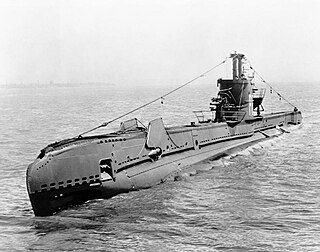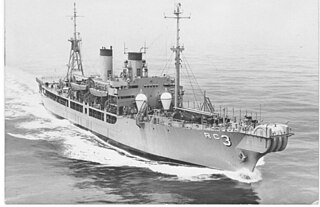Related Research Articles

USS Turbot (SS-427), a Balao-class submarine, was the second ship of the United States Navy to be named for the turbot, a large, brown and white flatfish, valued as a food.

The Centaur class aircraft carrier was the final iteration of the 1942 Design Light Fleet Carrier developed by the United Kingdom for the Royal Navy during the Second World War. They were designed in 1943 to operate higher-performance aircraft than the preceding Majestic-class aircraft carrier. Four ships were laid down in 1944-1945 and completed in 1953-1959. Rapid developments in carrier warfare and technology overtook the ships even as they were under construction, and the associated costs of modernization led to ships being completed to different specifications. Only the last ship, HMS Hermes (R12), was fitted as a modern fixed-wing carrier; she was also the last of the class to retire in 2017 as INS Viraat.

The S-class submarines of the Royal Navy were originally designed and built during the modernisation of the submarine force in the early 1930s to meet the need for smaller boats to patrol the restricted waters of the North Sea and the Mediterranean Sea, replacing the British H-class submarines. As part of the major naval construction for the Royal Navy during the Second World War, the S class became the single largest group of submarines ever built for the Royal Navy. A total of 62 were constructed over a period of 15 years, with fifty of the "improved" S class being launched between 1940 and 1945.

USS Vermilion (AKA-107/LKA-107), was a Tolland-class attack cargo ship of the United States Navy, named after a parish in southern Louisiana and a county in eastern Illinois. She served as a commissioned ship for 25 years and 9 months.

USS Skagit (AKA-105/LKA-105) was a Tolland-class attack cargo ship in service with the United States Navy from 1945 to 1949 and from 1950 to 1969. She was scrapped in 1974.

USS Ottawa (AKA-101) was a Tolland-class attack cargo ship in service with the United States Navy from 1945 to 1947. She was sold into commercial service and was lost in 1951.

USS Venango (AKA-82) was a Tolland-class attack cargo ship in service with the United States Navy from 1945 to 1946. She was sold into commercial service and was scrapped in 1971.

USS Waukesha (AKA-84) was a Tolland-class attack cargo ship in service with the United States Navy from 1945 to 1946. She was sold into commercial service and was scrapped in 1970.

USS Woodford (AKA-86) was a Tolland-class attack cargo ship in service with the United States Navy from 1945 to 1946. She was sold into commercial service and was scrapped in 1973.

Attack transport is a United States Navy ship classification for a variant of ocean-going troopship adapted to transporting invasion forces ashore. Unlike standard troopships – often drafted from the merchant fleet – that rely on either a quay or tenders, attack transports carry their own fleet of landing craft, such as the landing craft, vehicle, personnel (LCVP) or Higgins boat.

USS Rolette (AKA-99) was an Andromeda-class attack cargo ship named after a county in North Dakota.
Walsh-Kaiser Co., Inc. was a shipyard in both Cranston and Providence, Rhode Island. It was built during World War II and financed by the Maritime Commission as part of the country's Emergency Shipbuilding Program. It was originally operated by Rheem Manufacturing, a company with no previous shipbuilding expertise. When Rheem had difficulty managing the yard, Kaiser Shipyards was retained to manage the operation.
USS Valeria (AKA-48) was an Artemis-class attack cargo ship named after the minor planet 611 Valeria, discovered in 1906 by Joel Hastings Metcalf, an amateur astronomer who made the initial identification of 41 minor planets. The meaning of the name is unknown. Valeria served as a commissioned ship for 8 months.

USS Turandot (AKA-47) was an Artemis-class attack cargo ship named after the minor planet 530 Turandot, discovered by Max Wolf in 1904 and named by him after the title character in the Puccini opera of the same name.
USS San Joaquin (AKA-109) was a Tolland-class attack cargo ship whose keel was laid on 17 August 1945, eleven days after the atomic bombings of Hiroshima and Nagasaki which ended World War II. Further construction was cancelled on 27 August 1945.
USS Whitfield (AKA-111) was an Andromeda class attack cargo ship whose construction was cancelled due to the end of World War II. She was named after Whitfield County, Georgia.
HMS Superb was a Minotaur-class light cruiser of the Royal Navy. The ship entered service in 1945 and had a brief, quiet career before being decommissioned in 1957 after her modernisation was cancelled. She was broken up in 1960.

The Barnegat class was a large class of United States Navy small seaplane tenders (AVP) built during World War II. Thirty were completed as seaplane tenders, four as motor torpedo boat tenders, and one as a catapult training ship.

The Ukuru-class escort ships were a class of twenty kaibōkan escort vessels built for the Imperial Japanese Navy during World War II. The class was also referred to by internal Japanese documents as the "Modified B-class" coastal defense vessel, and they were the fourth class of kaibōkan.
References
This article incorporates text from the public domain Dictionary of American Naval Fighting Ships .The entry can be found here.